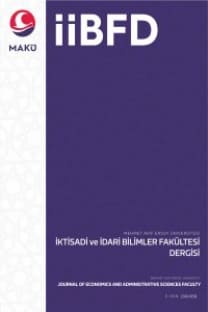ÜÇ BOYUTLU MERMER KESME PROBLEMİ İÇİN BİR TAM SAYILI DOĞRUSAL PROGRAMLAMA MODELİ
Mermer kesme problemi, Tam sayılı doğrusal programlama, Atık minimizasyonu.
AN INTEGER LINEAR PROGRAMMING MODEL FOR THE THREE-DIMENSIONAL MARBLE CUTTING PROBLEM
___
- Akbulut, H., ve Gürer, C. (2007). Use of aggregates produced from marble quarry waste in asphalt pavements. Building and environment, 42(5), 1921-1930.
- Aksu, D. T., Durak B. (2016). A dynamic programming algorithm for the online cutting problem with defects and quality grades. IFAC-PapersOnLine 49(12), 17-22.
- Alves, C., Bras, P., Valerio de Carvalho, J. M., ve Pinto, T. (2012). A variable neighborhood search algorithm for the leather nesting problem. Mathematical Problems in Engineering, 2012.
- Baykasoğlu, A., ve Özbel, B. K. (2021). Modeling and solving a real-world cutting stock problem in the marble industry via mathematical programming and stochastic diffusion search approaches. Computers ve Operations Research, 128, 105173.
- Bilgin, N., Yeprem, H. A., Arslan, S., Bilgin, A., Günay, E., ve Marşoglu, M. (2012). Use of waste marble powder in brick industry. Construction and Building Materials, 29, 449-457.
- Brás, P., Alves, C., de Carvalho, J. V., ve Pinto, T. (2010). Exploring new constructive algorithms for the leather nesting problem in the automotive industry. IFAC Proceedings Volumes, 43(17), 225-230.
- Diyaley, S., ve Chakraborty, S. (2022). Metaheuristics-based nesting of parts in sheet metal cutting operation. Operational Research in Engineering Sciences: Theory and Applications, 5(2), 1-16.
- Durak, B., Aksu, D. T. (2017). Dynamic programming and mixed integer programming based algorithms for the online glass cutting problem with defects and production targets. International Journal of Production Research, 55(24), 7398-741.
- Eroğlu, D. Y., Orbak, A. Y. (2020). Simulated Annealing Algorithm and Implementation Software for Fabric Cutting Problem. Textile and Apparel, 30(1), 10-19.
- Ersoy, M., ve Yeşilkaya, L. (2013). Choice of marble block cutting machine by using Analytic Hierarchy Process (AHP) method. International Journal of Information Technology and Business Management, 19(1), 67-80.
- Gazi, A., Skevis, G., ve Founti, M. A. (2012). Energy efficiency and environmental assessment of a typical marble quarry and processing plant. Journal of cleaner production, 32, 10-21.
- Hebhoub, H., Aoun, H., Belachia, M., Houari, H., ve Ghorbel, E. (2011). Use of waste marble aggregates in concrete. Construction and Building Materials, 25(3), 1167-1171.
- Kahraman, B. (2011). Three dimensional cutting problem: an integer programming approach. Mathematical and Computational Applications, 16(1), 105-112.
- Maden Tetkik ve Arama Müdürlüğü (2022). Erişim adresi: https://www.mta.gov.tr/v3.0/bilgi-merkezi/maden-dis-ticaret
- Marvila, M. T., Alexandre, J., de Azevedo, A. R., ve Zanelato, E. B. (2019). Evaluation of the use of marble waste in hydrated lime cement mortar based. Journal of Material Cycles and Waste Management, 21(5), 1250-1261.
- Menningen, J., Siegesmund, S., Lopes, L., Martins, R., ve Sousa, L. (2018). The Estremoz marbles: an updated summary on the geological, mineralogical and rock physical characteristics. Environmental earth sciences, 77(5), 1-31.
- MKS Makina (2022 a). Erişim adresi: https://www.mks.com.tr/tr/urun/blok-kesme-este-st-makinesi-.html#
- MKS Makina (2022 b). Erişim adresi: https://www.mks.com.tr/tr/urun/kafa-kesme-boy-ebatlama-makinesi-.html
- Orhan, H., ve Arık, F. (2019). Doğal taşların işletme mevzuatı ve çevre dostu uygulama örnekleri. Mavi Gezegen Popüler Yerbilim Dergisi, 26, 14-25.
- Özfirat, P. M. (2012). An integer programming approach for the three-dimensional cutting planning problem of marble processing industry. The International Journal of Advanced Manufacturing Technology, 59(9), 1057-1064.
- Petunin, A. A., ve Stylios, C. (2016). Optimization models of tool path problem for CNC sheet metal cutting machines. IFAC-PapersOnLine, 49(12), 23-28.
- Plankovskyy, S., Tsegelnyk, Y., Shypul, O., Pankratov, A., ve Romanova, T. (2020). Cutting irregular objects from the rectangular metal sheet. In Integrated Computer Technologies in Mechanical Engineering (pp. 150-157). Springer, Cham.
- Rodrigues, C. D., Cherri, A. C., ve de Araujo, S. A. (2023). Strip based compact formulation for two-dimensional guillotine cutting problems. Computers & Operations Research, 149, 106044.
- Siegesmund, S., ve Török, Á. (2011). Building stones. In Stone in Architecture (pp. 11-95). Springer, Berlin, Heidelberg.
- Ticaret Bakanlığı (2021). Erişim adresi: https://ticaret.gov.tr/data/5b87000813b8761450e18d7b/Do%C4%9Fal%20Ta%C5%9Flar%20Sekt%C3%B6r%20Raporu%202021.pdf
- Traverso, M., Rizzo, G., ve Finkbeiner, M. (2010). Environmental performance of building materials: life cycle assessment of a typical Sicilian marble. The international journal of life cycle assessment, 15(1), 104-114.
- Tsao, Y. C., Delicia, M., ve Vu, T. L. (2022). Marker planning problem in the apparel industry: Hybrid PSO-based heuristics. Applied Soft Computing, 123, 108928.
- ISSN: 2149-1658
- Yayın Aralığı: Yılda 3 Sayı
- Yayıncı: Mehmet Akif Ersoy Üniversitesi İktisadi ve İdari Bilimler Fakültesi
KOBİ`LERDE STRATEJİK PAZARLAMA YÖNETİMİ: LÜLEBURGAZ ÖRNEĞİ
Onur ŞAYLAN, Yusuf ESMER, Pelin ÇELİK
YEŞİL İŞLER ÜZERİNE YAPILAN ÇALIŞMALARIN BİBLİYOMETRİK ANALİZ YÖNTEMİ İLE İNCELENMESİ
Şerife DURMAZ, Aydın ÇİVİLİDAĞ, Murşit IŞIK
Nahit KÖKER, Cevat Sercan ÖZER
KÜRESEL HURDA DEMİR TİCARETİ İLİŞKİLERİNİN SOSYAL AĞ ANALİZİ YÖNTEMİYLE DEĞERLENDİRİLMESİ
GENEL HASTANELERİN YATAK KULLANIM PERFORMANSININ PABON LASSO YÖNTEMİYLE DEĞERLENDİRİLMESİ
Ferda IŞIKÇELİK, İsmail AĞIRBAŞ
"MEKSİKA DALGASI": ÜNİVERSİTE ÖĞRENCİLERİNİN COVID-19 İLE İLGİLİ BİLİŞSEL YAPILARININ ANALİZİ
Ramazan ERDEM, Elif KAYA, Necla YILMAZ, Ahmet ALKAN, İzzet ERDEM
Ethem TOPÇUOĞLU, Erdoğan KAYGIN
BÜYÜKŞEHİR BELEDİYE MODELİNDE HİZMET PAYLAŞIMI ANALİZİ: KATI ATIK YÖNETİMİ VE TEMİZLİK HİZMET ALANI
